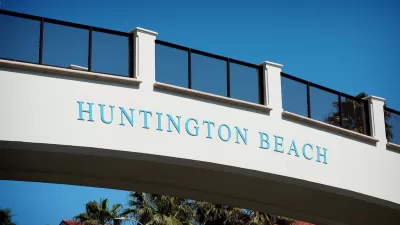The Southern California Association of Governments rebuffed the CA Air Resources Board by deliberately setting lower targets for greenhouse gas emissions per SB 375, the 2008 law intended to reduce GHG emissions from transportation.
The building lobby was successful in convincing the southern California metropolitan planning organization board members to lower these targets, in effect reducing the incentive to encourage denser, less auto-dependent development.
"Instead of setting the goal of reducing Greenhouse Gas Emissions by 8% in 2020 and 13% in 2035 as recommended by the state's Air Resource Board after a lengthy public process, SCAG chose to set goals of 6% reduction in 2020 and 8% in 2035. The 8/13 targets were rejected by a 21 to 29 vote. Unfortunately, this means that design standards and community plans throughout the region will have less density, encourage fewer transportation options, and create less vibrant communities with less open space over the next twenty five years than they would have if SCAG would have followed the state board's recommendations."
Meanwhile, environmentalists scorned the decision. (An) Associated Press article quotes a frustrated representative of the American Lung Association, while other articles quote (Natural Resource Defense Council's) Amanda Eaken, who has emerged as something of an expert on this issue. Locally, ClimatePlan staffer and Streetsblog contributor Gloria Ohland commented simply that "we have more work to do."
Thanks to The Transit Coalition
FULL STORY: SCAG Takes a Pass on History, Moves Forward with Lower GHG Reductions

Alabama: Trump Terminates Settlements for Black Communities Harmed By Raw Sewage
Trump deemed the landmark civil rights agreement “illegal DEI and environmental justice policy.”

Study: Maui’s Plan to Convert Vacation Rentals to Long-Term Housing Could Cause Nearly $1 Billion Economic Loss
The plan would reduce visitor accommodation by 25% resulting in 1,900 jobs lost.

Planetizen Federal Action Tracker
A weekly monitor of how Trump’s orders and actions are impacting planners and planning in America.

Waymo Gets Permission to Map SF’s Market Street
If allowed to operate on the traffic-restricted street, Waymo’s autonomous taxis would have a leg up over ride-hailing competitors — and counter the city’s efforts to grow bike and pedestrian on the thoroughfare.

Parklet Symposium Highlights the Success of Shared Spaces
Parklets got a boost during the Covid-19 pandemic, when the concept was translated to outdoor dining programs that offered restaurants a lifeline during the shutdown.

Federal Homelessness Agency Places Entire Staff on Leave
The U.S. Interagency Council on Homelessness is the only federal agency dedicated to preventing and ending homelessness.
Urban Design for Planners 1: Software Tools
This six-course series explores essential urban design concepts using open source software and equips planners with the tools they need to participate fully in the urban design process.
Planning for Universal Design
Learn the tools for implementing Universal Design in planning regulations.
Caltrans
Smith Gee Studio
Institute for Housing and Urban Development Studies (IHS)
City of Grandview
Harvard GSD Executive Education
Toledo-Lucas County Plan Commissions
Salt Lake City
NYU Wagner Graduate School of Public Service





























